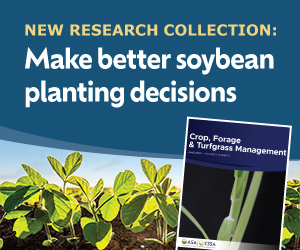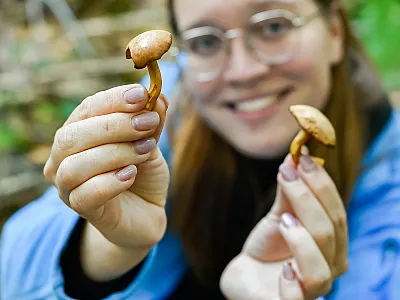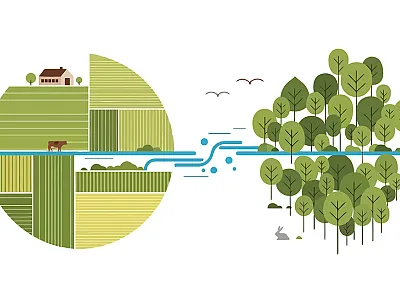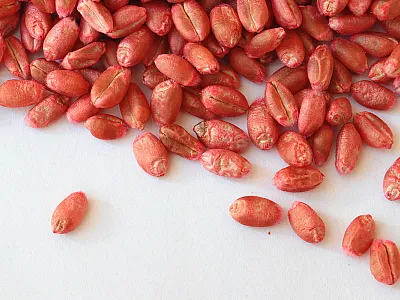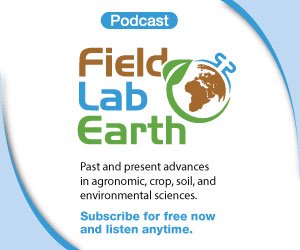PFAS and agriculture: What we’ve learned in Maine
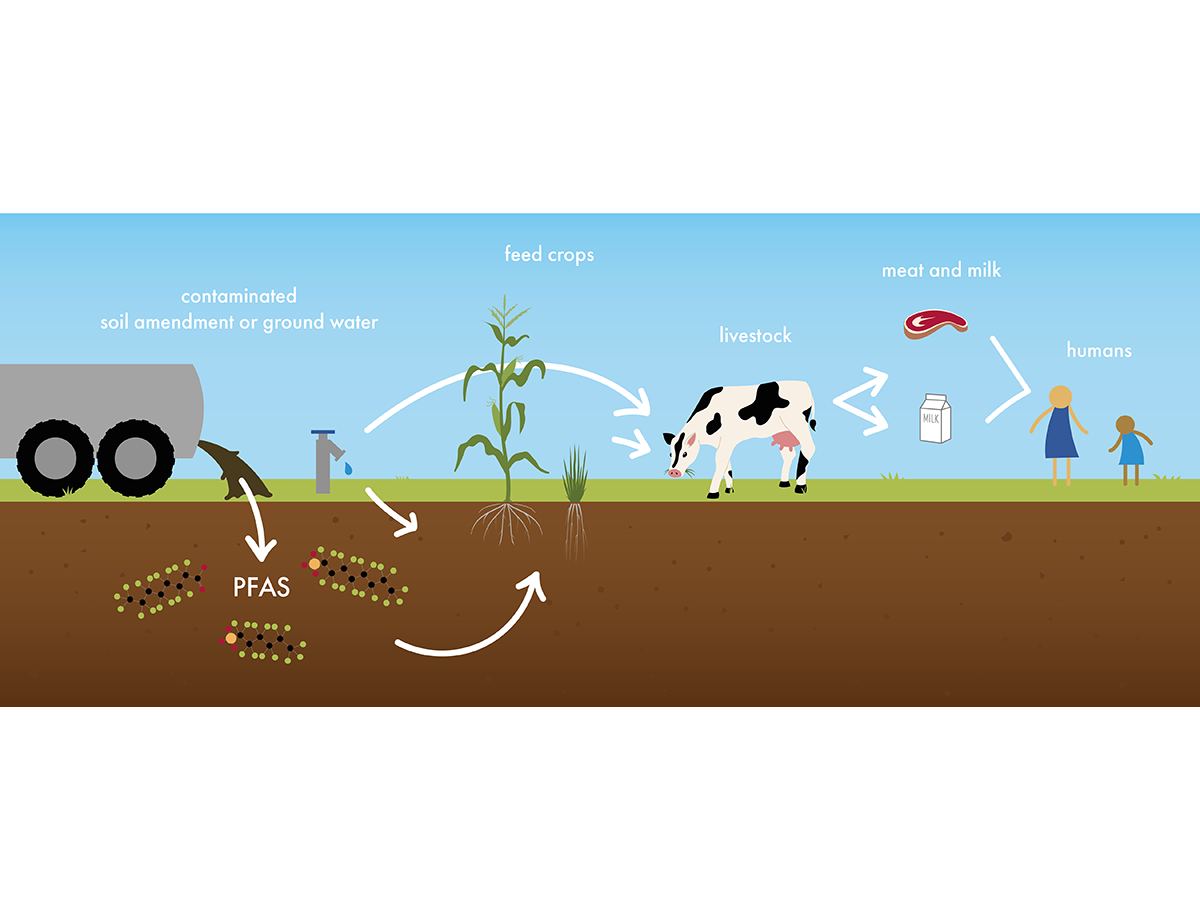
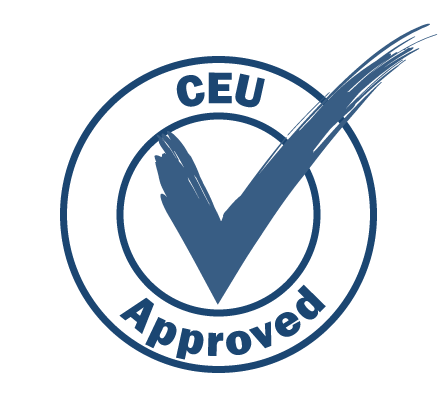
Per- and polyfluoroalkyl substances (PFAS) contamination on farms is increasingly in the news. These man-made chemicals, which have been in production since the 1940s, are now ubiquitous in our environment and linked to several human health risks. PFAS may be found at farms due to contaminated air, water, and soil amendments (like biosolids) and enter the food chain. Maine is one of the leaders in responding to PFAS contamination in agriculture. In this article, we provide background on the issue, describe Maine’s experience and response, highlight ongoing research in the state, and provide recommendations for advising farmers concerned about contamination. Earn 1 CEU in Soil & Water Management by reading this article and taking the quiz.
Per- and polyfluoroalkyl substances (PFAS) include tens of thousands of synthetic chemicals that repel oil, grease, water, and heat. They became widely used in industrial settings as early as the 1940s and have been used in many commercial products as well, such as non-stick cookware and stain-resistant carpets. PFAS molecules contain one or more carbon-fluorine bonds, which are extremely strong and resistant to decomposition in the environment; hence, they are often referred to as “forever chemicals.” Their persistent nature means PFAS may accumulate in people, animals, and the environment over time. Studies suggest that these chemicals may affect cholesterol levels, thyroid function, birth weight, liver function, infant development, immunity, and may increase the risk of some cancers, including liver, kidney, and testicular cancers (NASEM, 2022).
PFAS can enter agricultural systems via contaminated air, water, and by applying biosolids. Potential sources of contamination include industrial emissions, aqueous firefighting foams (AFFF), municipal and industrial wastes via biosolids, and pesticides. While land application of biosolids as fertilizers and soil amendments is a widespread practice across the U.S. and remains an approved method by the USEPA, it can be a route for introducing PFAS if wastewater sources are contaminated. Of note, but not discussed here, is the role that PFAS organofluorine pesticides play in the rapid rise in concentrations of the ultrashort-chain PFAS trifluoroacetate (TFA) observed in water, air, and food since 2010 (Arp et al., 2024).
Once PFAS enter soil or water, they can be taken up by crops, primarily through roots, and then by animals eating those crops or drinking contaminated water (see Figure 1 above). PFAS vary in their mobility, with shorter-chain PFAS being more soluble and mobile, and longer chain PFAS being less mobile. Thus, PFAS movement through agricultural systems is influenced by the specific PFAS compound as well as soil, plant, and animal characteristics and other factors.
Maine’s discovery and response to PFAS in agriculture
Maine’s agricultural community was first alerted to PFAS in 2016 when a dairy in southern Maine was identified by the Maine Department of Environmental Protection (DEP) due to PFAS detections in a nearby public water-monitoring well. The subsequent investigation identified soil, water, hay, and milk containing high PFAS concentrations, particularly the eight-carbon chain perfluorooctane sulfonic acid (PFOS). In 2017, the Maine Center for Disease Control (MECDC) developed action levels for PFOS in cows' milk and beef as guidance for the Maine Department of Agriculture, Conservation, and Forestry (DACF) to determine when those products should be considered adulterated and unsuitable for sale (MECDC, 2017). They later established a soil screening level to meet the prescribed PFOS action level for milk using the few published values available for the transfer of PFOS from soil to forage and from forage to milk (MECDC, 2020).
Governor Mills created the Maine PFAS Task Force in 2019 to determine the extent of PFAS contamination in the state and develop a response plan. Two more dairy farms with elevated PFOS levels in their milk were identified in 2020 through retail milk testing conducted by DACF. PFAS contamination at all three farms was tied to historical applications of biosolids from wastewater treatment facilities that had accepted industrial wastes. From 2020 onward, DACF, DEP, and MECDC worked closely with the impacted dairies: collecting and analyzing samples, tracking depuration, and advising on mitigation strategies. In 2022, the Maine State Legislature banned land application of biosolids in the state and directed Maine DEP to conduct a statewide PFAS investigation of soil and groundwater at all licensed sludge and septage sites.
In 2021, agricultural service providers from across state agencies, the University of Maine (UMaine) Extension, Maine Organic Farmers and Gardeners Association (MOFGA), and Maine Farmland Trust began providing information and support for the agricultural community around PFAS, and the non-profits raised funds to provide immediate financial support for impacted farmers. In 2022, Maine DACF formalized its PFAS Response Program to help impacted farms and protect consumers by identifying PFAS contamination, pursuing strategies to reduce or eliminate PFAS from the food supply, and providing technical and financial assistance to retain farm viability (DACF, 2025b). The Legislature also established “The Fund to Address PFAS Contamination,” which supports farmers, research, and public health through targeted financial assistance, grants, and health-related initiatives (DACF, 2025a). In conjunction with DACF, UMaine Extension runs a PFAS Navigator Program to help impacted farmers access this support and other resources.
Early research
A critical question for responding to contamination on farms is, How much is too much PFAS in the soils and water used in crop and animal production? When Maine first started confronting PFAS, there was little research literature, especially from field trials, that quantified the transfer of PFAS from soil to crops and from crops to animals and their products. Other important questions also needed to be addressed. For example, do some crops accumulate less PFAS than others? And can animals eliminate PFAS once contaminated? These questions led researchers and agricultural service providers at Maine’s state agencies (CDC, DACF, and DEP), UMaine, and MOFGA to begin working with impacted farmers to find answers.
Following are several key findings during this time:
Farms can continue operating and producing safe food despite having soil or water containing PFAS by filtering water, changing crops, and adjusting feeding strategies.
Knowing the field-wide soil PFAS concentrations for all areas of a farm is essential to assessing risk, given that concentrations can vary significantly within a single field.
Different types of PFAS compounds behave differently in water, soil, plants, and animals. For instance, PFOS accumulates in livestock, whereas many other PFAS do not (Kowalczyk et al., 2013; Lupton et al., 2011, 2015).
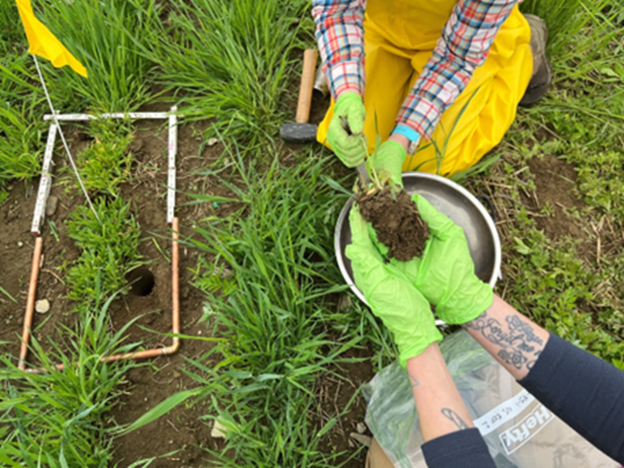
Plant uptake of PFAS can be highly variable with PFOS soil-to-plant transfer factors for perennial grass/legume hay, varying tenfold across farm fields in Maine (Figure 2). Higher concentrations of PFOS precursors (compounds that transform into PFOS) were associated with higher plant PFOS accumulation rates (Simones et al., 2024).
Certain types of crops accumulate less PFAS than others. In general, fruits and grains (plant reproductive parts) tend to have much lower PFAS concentrations than whole-plant forages and leafy greens (vegetative parts).
Levels of PFAS in livestock (blood, tissue, and milk) decrease over time once exposure is reduced or eliminated (Figure 3). The half-life of PFOS in dairy cows is estimated to be between 4 and 10 weeks (Lupton et al., 2025), and herds can be successfully depurated.
Composting contaminated animal carcasses does not reduce PFAS contamination, but it can play an important role in stabilizing and reducing the volume of contaminated material and preventing potential contamination of groundwater from burial.
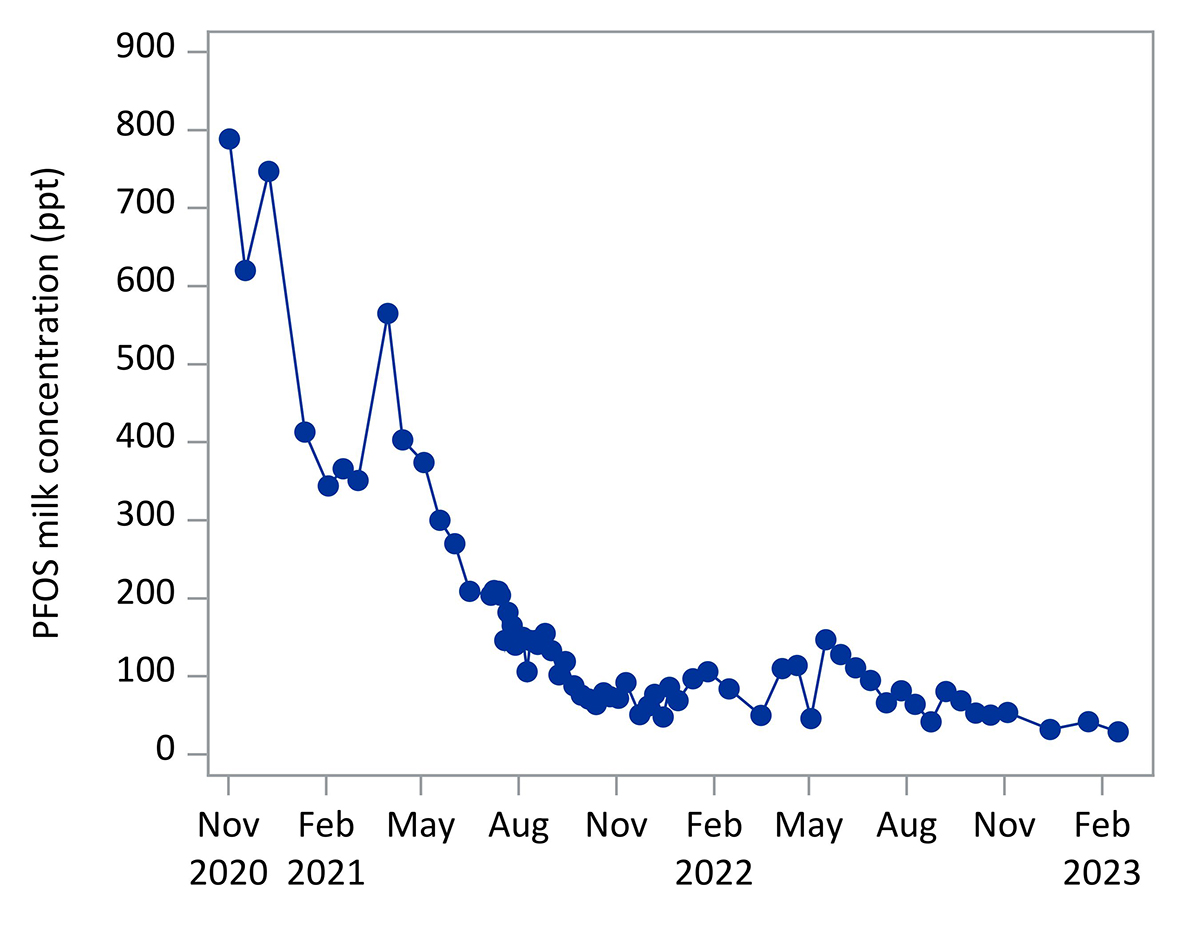
Maine’s ongoing response
To date, 90 of Maine’s over 7,000 commercial farms have been identified with PFAS levels above either Maine’s most conservative soil screening level (6.4 ppb PFOS) or Maine’s interim drinking water standard (20 ppt Sum6). The vast majority of impacted farms have continued to operate and produce safe food despite the presence of PFAS. Solutions do exist for reducing and eliminating PFAS exposure to plants and animals on a farm.
Where groundwater is contaminated, treatment systems can be installed to filter PFAS out of drinking or irrigation water. Rotating livestock onto fields and feed with lower levels or no PFAS several months before processing them can decrease PFAS levels found in meat. For certain producers, switching from perennial forages to a grain like corn can reduce the amount of PFAS going into livestock. Additionally, harvesting earlage or snaplage instead of corn silage could lower exposure because PFOS doesn’t accumulate as much in grains as it does in vegetative growth. Vegetable farmers can rotate crops with less propensity to accumulate PFAS, like tomatoes, broccoli, or beans, to areas of their farm where PFAS levels are higher and focus their leafy greens production on areas with lower soil PFAS levels.
Recommendations for crop advisers
The first step in helping farmers assess PFAS risk on their farm is to understand if there is cause for concern. Is the farm near a facility with potential PFAS contamination (e.g., an airport that has used AFFF or a manufacturing plant that uses or produces PFAS) or does the farm have a history of biosolid application? Some states have online maps or records of locations that were licensed for biosolid application. It is important to note that not all biosolids contain PFAS at levels that will result in detrimental effects on agricultural operations. See the USEPA’s January 2025 factsheet, “Draft Sewage Sludge Risk Assessment for PFOA and PFOS: Information for Farmers” for more information.
If there is cause for concern, the farmer may want to test their soil, water, or both. PFAS testing is costly, especially if it is necessary to test multiple fields, water sources, and/or products. It is also easy to contaminate PFAS samples. Therefore, it is recommended to work with a field technician trained in PFAS sample collection and analysis to determine what and how to test and collect samples. For livestock farmers, additional testing of milk and serum of live animals might be required. A testing payment program is available from NRCS and may also be available from your local state agencies or non-profits. Consideration should be given to any reporting requirements.
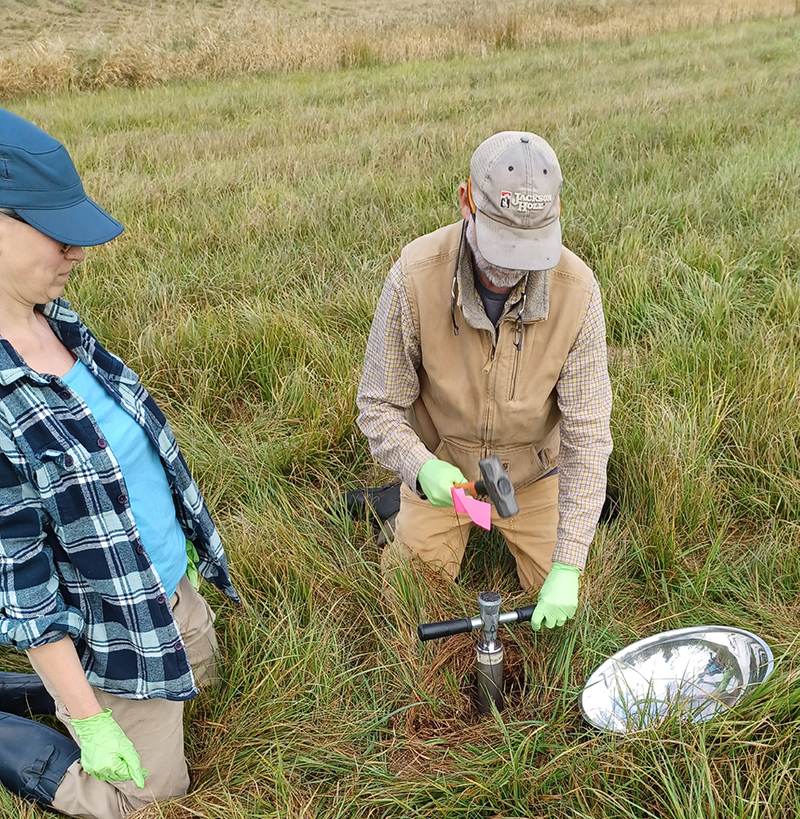
PFAS test results are not always easy to understand and interpret, which is another reason to work with a trained technician. An additional complicating factor is that, while the USEPA has a maximum contamination level for drinking water, there is currently no guidance for water used for livestock or irrigation at the state or federal level. Maine is currently the only state that has screening levels for agricultural soil and action levels for agricultural products (for milk and beef at present).
As a first step, farmers should evaluate the safety of their own drinking water. The USEPA’s finalized drinking water standard, released last year, sets a limit of 4 ppt for PFOA and PFOS individually, 10 ppt for the sum of four other PFAS, and a Hazard Index of 1 (DEP, 2025). Then, if water exceeds the USEPA limits or if soil levels exceed Maine’s initial screening level (6.4 ppb of PFOS), a farmer may want to develop a mitigation plan that includes multiple strategies like those being used by forage and livestock farmers in Maine. Farmers may also want to contact state agencies if the state has support programs for PFAS contamination or apply for Dairy Indemnity Payment Program support via the USDA Farm Service Agency.
PFAS mitigation strategies for forage and livestock producers
Install filters to reduce PFAS levels in water.
Grow corn silage, snaplage, or grains instead of perennial forages on contaminated fields and corn snaplage or grains on the most highly contaminated field(s).
Alter grazing and feeding strategies to minimize the impact on livestock. Dilute contaminated forage with non-contaminated forage and use clean pastures and feed during critical times. To implement this strategy, it is important to label bales or keep records of the fields from which they were harvested. Likewise, bunker silos should be segregated by fields if possible or filled in a way that avoids the possibility of feeding out undiluted feed (Figure 4).
For dairy animals, minimize feeding contaminated feed to calves and heifers because any PFAS bioaccumulated during this time can contaminate milk during the first lactation.
Monitor PFAS levels in milk and beef over time to track the effectiveness of mitigation strategies (Figure 5).
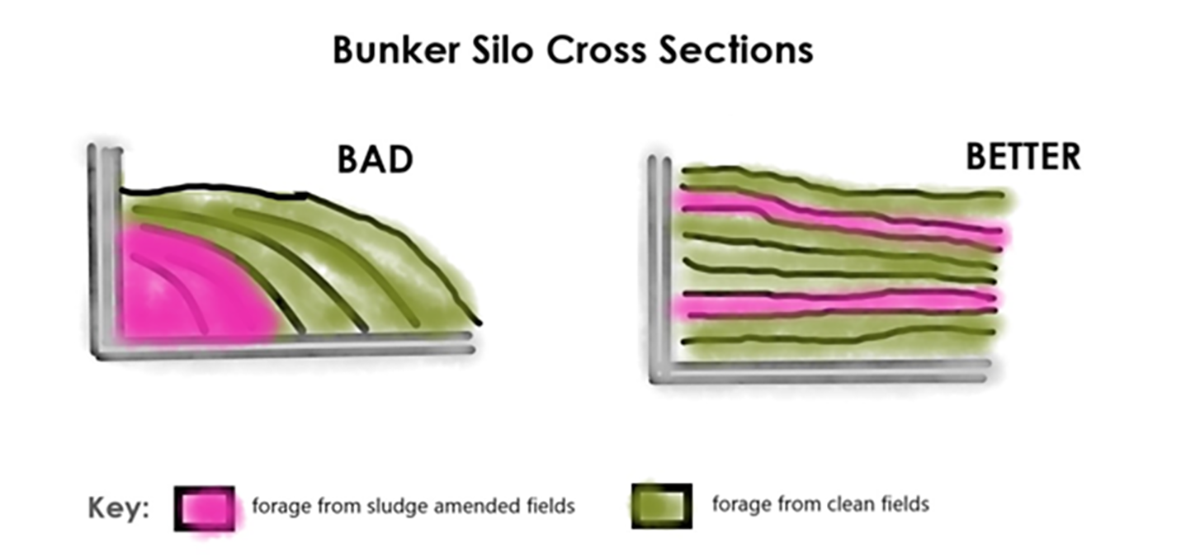
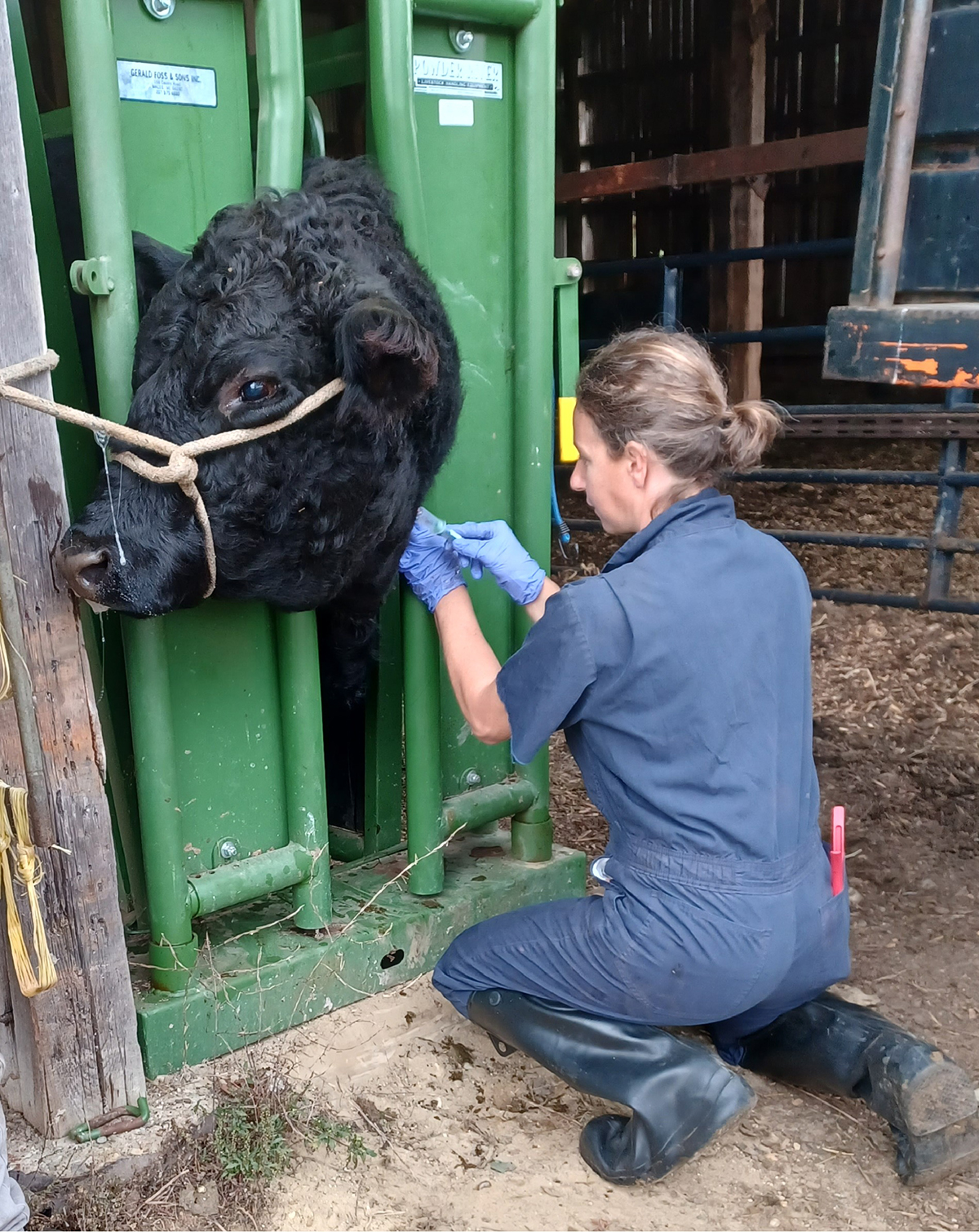
More information can be found in the University of Maine Extension publication, Guide to Investigating PFAS Risk on Your Farm, and the DACF publication, Recommendations to Farmers Managing PFAS Risk: Cattle—Meat, Dairy, and Feed.
Ongoing research in Maine
The recommendations above will evolve as we learn more through experience and research. The research on PFAS and agriculture ongoing in Maine falls into three major areas: risk assessment, remediation, and mitigation.
Risk assessment research spans topics such as farmworker exposure, environmental factors that affect plant PFAS uptake, and PFAS testing technologies. Researchers are quantifying worker exposure to contaminated soil via inhalation, dermal contact, and other means to evaluate health risks for farmers. They are also assessing the influence of specific plant and soil characteristics on plant PFAS uptake to improve our ability to predict the risk of growing specific crops on specific fields. To facilitate these and other PFAS research areas, rapid and inexpensive detection methods for PFAS in water, soil, and plants are being explored, employing technology such as nuclear magnetic resonance (NMR) spectroscopy, and nanomaterials.
Phytoremediation is currently the primary remediation strategy being tested for agricultural soils in Maine. While grass crops do not seem particularly promising for this purpose, given the high soil PFAS concentrations that remain in perennial forage fields, other more “classic” hyperaccumulators, such as hemp, are the subjects of studies in the state. So far, researchers here have found that hemp uptake rates for shorter-chain PFAS compounds were promising for phytoremediation to be viable, but not so for longer-chain compounds like PFOS (Nason et al., 2024). The fate of the resulting plant material remains in question though options like thermochemical destruction are being investigated.
For mitigation, scientists and engineers from different backgrounds are collaborating to identify both short- and long-term strategies. For example, researchers are assessing various forage management options to develop advice on which crops to grow and how best to manage them to ensure clean products given low to moderate soil contamination levels. Choices include species, cutting height, harvest timing, fertility, and harvested product. The use of biochar is being studied to characterize its ability to bind, or immobilize, soil PFAS, making it unavailable to plants for uptake. The amount of time the PFAS will remain bound and the rate at which it may eventually be released are also being studied to determine the extent to which this material may be used to address soil contamination.
In the realm of livestock research, scientists are developing models to better understand PFAS accumulation and depuration in animals as well as health impacts. PFAS immobilization is also being studied as a mitigation strategy for livestock. Researchers are evaluating the potential of feed binders to prevent animal uptake when contaminated feed is used, much as is done for mycotoxins. They are also examining whether the use of these binders causes PFAS to accumulate in the solid fraction of biodigested manure, making the liquid fraction safe to apply to fields, thus breaking PFAS cycling on the farm. While cows have been the major focus of much of this animal research, studies are underway to investigate PFAS accumulation and depuration in sheep and lambs as well as how soil contamination affects the levels of PFAS in poultry and eggs, diversifying our understanding of how these chemicals enter and exit the food system.
Resources to learn more
PFAS Response Kit for Impacted Farms in Maine (Maine DACF PFAS Fund)
Guide to Investigating PFAS Risk on Your Farm (University of Maine Extension)
Assessing PFAS Contamination and Managing Risks on Dairy Farms in Maine (Maine DACF PFAS Response)
Federal Dairy Indemnity Payment Program (DIPP; Farm Service Administration)
Draft Sewage Sludge Risk Assessment for PFOA and PFOS: Information for Farmers (USEPA)
Arp, H.P.H., Gredelj, A., Glüge, J., Scheringer, M., & Cousins, I.T. (2024). The global threat from the irreversible accumulation of trifluoroacetic acid (TFA). Environmental Science & Technology, 58(45), 19925-19935. DOI: 10.1021/acs.est.4c06189
DACF. (2025a). Fund to Address PFAS Contamination. Maine Department of Agriculture, Conservation and Forestry. https://www.maine.gov/dacf/ag/pfas/pfas-fund.shtml.
DACF. (2025b) PFAS response. Maine Department of Agriculture, Conservation and Forestry. https://www.maine.gov/dacf/ag/pfas/pfas-response.shtml.
DEP. (2025). Per- and polyfluoroalkyl substances (PFAS). Maine Department of Environmental Protection. https://www.maine.gov/dep/spills/topics/pfas/.
Kowalczyk, J., Ehlers, S., Oberhausen, A., Tischer, M., Fürst, P., Schafft, H., & Lahrssen-Wiederholt. (2013). Absorption, distribution, and milk secretion of the perfluoroalkyl acids PFBS, PFHxS M., PFOS, and PFOA by dairy cows fed naturally contaminated feed. Journal of Agricultural and Food Chemistry, 61, 12:2903–2912. https://pubs.acs.org/doi/10.1021/jf304680j
Lupton, S. J., Dearfield, K. L., Johnston, J. J., Wagner, S., & Huwe, J.K. (2015). Perfluorooctane sulfonate plasma half-life determination and long-term tissue distribution in beef cattle (Bos taurus). Journal of Agricultural and Food Chemistry, 63(44), 10002–10010. https://pubs.acs.org/doi/10.1021/acs.jafc.5b04565
Lupton, S.J., Huwe, J. K., Smith, D. J., Dearfield, K. L., & Johnston, J. J. (2011). Absorption and excretion of 14C-perfluorooctanoic acid (PFOA) in angus cattle (Bos taurus). Journal of Agriculturural & Food Chemistry, 60, 1128−1134. https://doi.org/10.1021/jf2042505
Lupton, S.J., Smith, D.J., Howey, E.B., Predgen, A.S., Schmidt, C.E., Scholljegerdes, E., Ivey, S., Esteban, E., & Johnston, J.J. (2025). Tissue histology and depuration of per- and polyfluoroalkyl substances (PFAS) from dairy cattle with lifetime exposures to PFAS-contaminated drinking water and feed. Food Additives & Contaminants, Part A, 42(2), 223–239. https://doi.org/10.1080/19440049.2024.2444560
MECDC. (2017). Action levels for PFOS in cow’s milk. Memorandum to the Department of Agriculture, Conservation and Forestry from the Maine CDC, March 28, 2017. Maine Center for Disease Control and Prevention. https://www.maine.gov/dep/spills/topics/pfas/Derivation-of-Action-Levels-for-PFOS-in-Cows-Milk-03.28.17.pdf
MECDC, T. (2020). Derivation of PFOS soil screening levels for a soil-to-fodder-to-cow's milk agronomic pathway. Maine Center for Disease Control and Prevention. https://www.maine.gov/dep/spills/topics/pfas/Agronomic-Pathway-Soil-Screening-Levels-Soil-Fodder-Cows-Milk-09.16.20.pdf
NASEM. (2022). Guidance on PFAS exposure, testing, and clinical follow-up (pp. 62–63). National Academies of Sciences, Engineering, and Medicine. https://doi.org/10.17226/26156
Nason, S. L., Thomas, S., Stanley, C., Silliboy, R., Blumenthal, M., Zhang, W., Liang, Y., … & Berger, B. W. (2024). A comprehensive trial on PFAS remediation: hemp phytoextraction and PFAS degradation in harvested plants. Environmental Science Advances 3(2), 304–313. https://doi.org/10.1039/d3va00340j
Simones, T.L., Evans, C., Goossen, C.P., Kersbergen, R., Mallory, E.B., Genualdi, S., Young, W., & Smith, A.E. (2024). Uptake of per- and polyfluoroalkyl substances in mixed forages on biosolid-amended farm fields. Journal of Agricultural and Food Chemistry, 7, 23108–23117.
Self-study CEU quiz
Earn 1 CEU in Soil & Water Management by taking the quiz for the article. For your convenience, the quiz is printed below. The CEU can be purchased individually, or you can access as part of your Online Classroom Subscription.
What chemical property makes PFAS compounds resistant to decomposition in the environment?
a. Toxicity to mammals.
b. Carbon-fluorine bonds.
c. Reactivity with the environment.
d. Heat resistance.
According to the article, how do short-chain PFAS differ from long-chain PFAS?
a. Short-chain PFAS are more soluble and more mobile than long-chain PFAS.
b. Long-chain PFAS are more soluble and mobile than short-chain PFAS.
c. Short-chain PFAS are more common than long-chain PFAS.
d. Long-chain PFAS are more harmful than short-chain PFAS
The mission of the Maine DACF PFAS Response Program is to help impacted farmers and protect consumers by identifying PFAS contamination and pursuing strategies to reduce or eliminate PFAS from the food supply.
a. True.
b. False.
What did research from Lupton et al. and Kowalczyk et al. identify regarding PFAS in livestock?
a. All PFAS compounds behave similarly in water, soil, plants and animals.
b. PFAS accumulate in milk and PFOS accumulates in meat.
c. PFOS accumulates in livestock while other PFAS do not.
d. PFOS does not accumulate in the environment.
Which crops should NOT be grown as animal feed on PFAS-contaminated fields?
a. Grain.
b. Snaplage.
c. Perennial grasses.
d. Corn silage.
The first step in assessing risk for PFAS contamination on a farm is to
a. test soil for PFAS.
b. test water for PFAS.
c. Identify if the farm is near a facility with high PFAS contamination or has a history of biosolids application.
d. Identify visual symptoms in the fields of PFAS contamination.
Which states have action levels for PFAS in agricultural products?
a. Only Maine.
b. All the New England states.
c. Maine and New Hampshire.
d. None currently.
Composting PFAS-contaminated animal carcasses
a. reduces PFAS contamination.
b. reduces the volume of contaminated material.
c. prevents potential contamination from the burial of carcasses.
d. Both b and c.
e. All of the above.
Which of the following is NOT an area of ongoing research in Maine?
a. Prevention.
b. Risk Assessment.
c. Remediation.
d. Mitigation.
e. Both c and d.
PFAS levels in livestock can decrease over time, and herds can be successfully depurated.
a. True.
b. False.
Text © . The authors. CC BY-NC-ND 4.0. Except where otherwise noted, images are subject to copyright. Any reuse without express permission from the copyright owner is prohibited.



